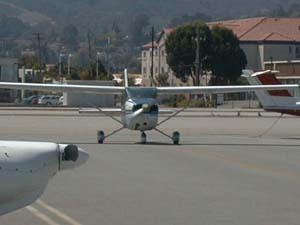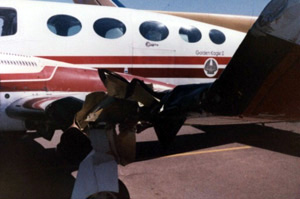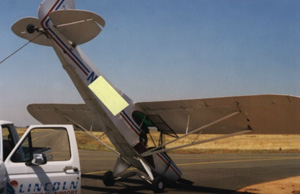
You would think that taxiing an aircraft is a relatively low risk proposition. We follow painted lines. We move at slow speeds. Ground traffic is often controlled by ATC. We have signs, rules, radios, and space to maneuver and yet this seemingly innocuous phase of aircraft operation results in numerous avoidable, expensive and embarrassing accidents. In fact, the odds of having an airplane accident during a ground operation are far greater than accidents due to airborne-related events. As I had mentioned in Part I of “Grounded”, part of the problem is that aircraft accidents on the ground are not well publicized and many pilots are unaware of the potential for trouble.

Just recently, I investigated a typical needless ground accident. A pilot had taxied his twin engine airplane to the run-up area, but had to hold on the taxiway as the run-up area was full. A Cessna 172 behind the twin became impatient and tried to cut in front of the twin. In doing so, the left wing of the 172 over-lapped the right wing of the twin. The 172’s wing got chopped up by the twin’s propeller. In spite of the considerable damage, it could have been worse had the 172’s gas tank ruptured causing a fuel spill and fire. All this because of one pilot’s impatience and bad judgment.
Of course we can read about this and say “I would never do anything like that”. Maybe so, but even if we avoid the obvious, accidents can occur when we are subject to distraction and inattention. Taxiing an aircraft is a seemingly undemanding task. It is easy to let our thoughts wander while moving on a spacious ramp. We are not “on guard” as there is no perceived danger. Some of us are even fiddling with avionics, charts, or checklists when we should be keeping our mind and eyes on the road.
About two years ago I had just landed at a large uncontrolled field and was taxiing on the main parallel taxiway toward the ramp. As I was approaching an intersection, a Piper Cub came darting out from an arterial taxiway completely oblivious to my presence and was headed towards the same intersection. Having just enough knowledge of Physics 101, to realize that two aircraft could not occupy the same space at the same time I stopped my plane about a 100 yards from the intersection. Even though I had already stopped well clear of the intersection, the sight of another airplane was enough to startle the Cub pilot into making a panic stop, not a good thing to do in a tail dragger.

In disbelief I watched as the Cub went over on its nose with the tail up in the air and the propeller trying to screw itself into the ground. To make matters worse, the pilot (of considerable girth) was stuck in the snug cockpit of the up-ended aircraft and fuel was pouring out of the wing tanks toward the hot engine and exhaust. I radioed the unicom for assistance and went over and helped extricate the Cub pilot out of the plane. Fortunately, there was no fire. Just a bent prop and bent ego.
A point of importance. The Cub pilot was no novice. He was an experienced, professional pilot who had a momentary lapse of attention as to where he was and what he was doing. As in the first example with the 172, the consequences could have been fatal if a fire had broken out. Don’t be lulled into feeling safe and secure because you are on the ground. When you are taxiing an aircraft, your level of attention and focus should be no less than when you are airborne.
Never play the “I think I can make it” game when trying to maneuver around aircraft on the ground, especially when parking. You either can or can’t clear it. If there is any doubt, shut it down and take a look. Don’t feel embarrassed if you have to get out the old tow bar or have someone help you push the plane if you find yourself in a tight spot. It is a far better decision than causing damage to two planes: your plane and the plane you hit. Also, don’t abdicate your judgment to well-meaning passengers, and passersby that are helping to guide you or reassure you that you will pass clear of a particular obstacle. Stay alert. I have even handled a number of claims involving pilots who were blindly following the direction of line people when they hit another aircraft or obstacle. As much as they would like to blame the line person, the Pilot-In-Command is still responsible for the safe operation of his aircraft. Never be lulled into a false sense of security just because you are following a painted line on the ground. It is not an insurance policy that will prevent you from hitting another parked plane, building, or other structure such as a utility pole. Scan for hazards as you do in flight and watch your wing tips.
Hazards while taxiing are not just limited to other aircraft. Taxiing over dips and depressions on the ground can cause a prop strike. Extra caution is needed on unpaved surfaces. Sometimes depressions will be camouflaged by standing water so as to look like an innocuous puddle. I handled one such prop-strike claim at SQL after a heavy rain had covered an otherwise well-marked, but recessed storm drain. When a nose gear enters even a small depression, the strut compresses which can bring prop clearance down to nil. Speaking of airport storm drains, be careful when taxiing over drains, grates and manhole covers. I have handled claims where these gave way under the weight of light planes causing prop strikes and serious airframe damage.
One of the most demanding aspects of taxiing can be trying to stay oriented at an unfamiliar airport. Anyone who has been to LGB (Long Beach) knows how intimidating an airport can be on the ground. Add in darkness or other forms of limited visibility at an unfamiliar or complex airport and you could find yourself wandering into trouble. Inadvertent runway incursions can and have had fatal results. Get ground-orientated as part of the preflight. Study the airport diagram, monitor the taxi signs and markings and never hesitate to ask ground control for “progressive taxi” either to or from the runway. If you become disorientated, stop where you are and figure it out. Don’t proceed blindly.
We’ve covered a lot of “ground” in this two-part series. You shouldn’t feel that the accident boogey-man is lurking in the shadows every time you get near a plane, but you need to be aware of some of the lesser known, but all too common potential traps for the unwary. Just use a little heads-up airmanship and you won’t be “grounded.”
Editor’s Note: This article was written by Ken Steiner prior to his retirement from the United States Aircraft Insurance Group as a Vice-President and Claims Manager. During his career, Ken investigated thousands of aircraft accidents involving small planes, crop dusters, helicopters, corporate aircraft, and airliners. He has been on-site at over 100 fatal aircraft accident investigations. He is currently an Aviation Investigative Consultant and is also a Pilot and Tactical Flight Officer for the San Mateo County Sheriff’s Air Support Unit. He owns a Cessna 182 based at San Carlos and holds ATP and CFI certificates with over 5000 flying hours.


